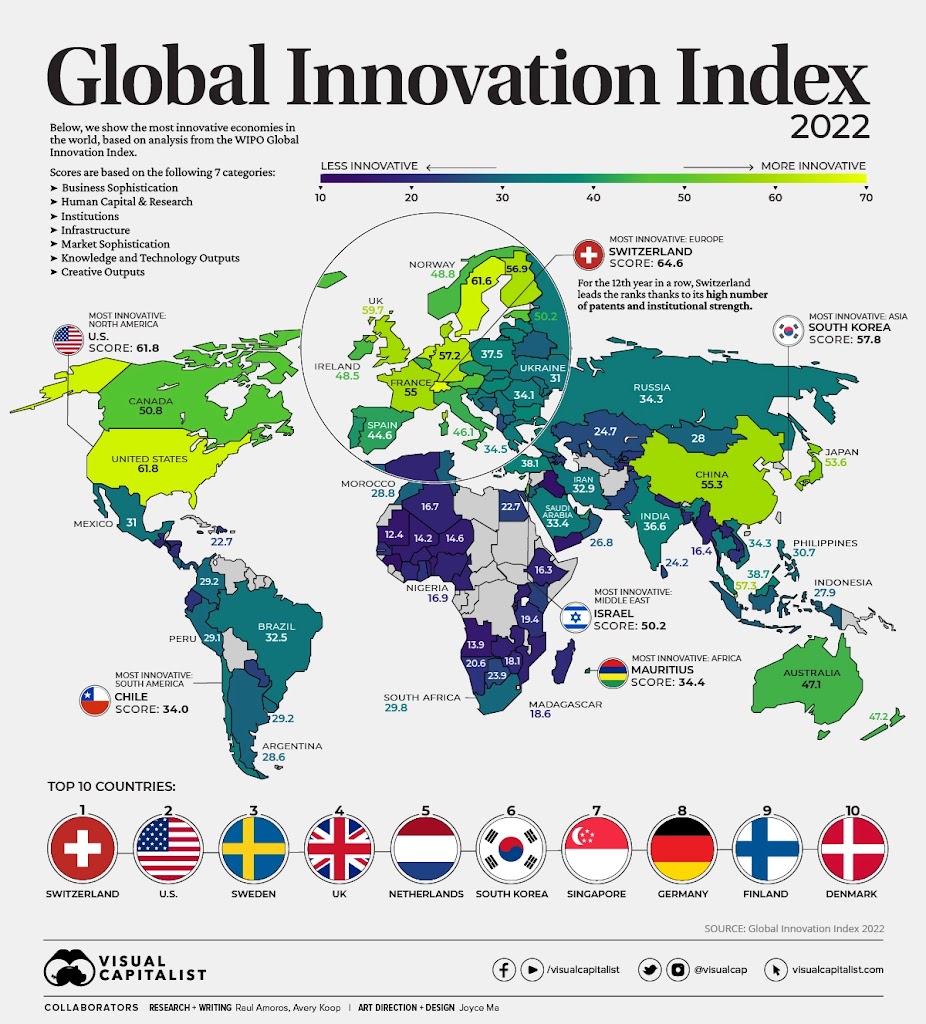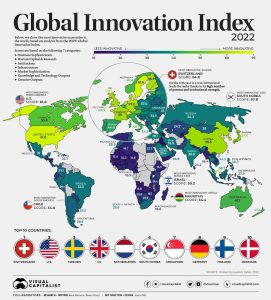This is a great summary of innovation by country from Visual Capitalist. See the Global Innovation Index (GII) map here:https://www.visualcapitalist.
First Published on IntellZine.com. Note the sustainability implications from innovation, and the lack of innovation.
We,
at Strategic Business Planning Company, www.SBP.com, are always
interesting in all aspects of innovation. Sometimes we hear from a
layperson or an executive that the most innovative country in the work
is …
Israel and Ireland were
mentioned in recent years. One executive said that “all innovation
comes from Israel”. All right, admittedly, Israel is a great source of
innovation and invention, but it is a very small country (population,
GDP). In absolute terms, Israel is not even close, but in relative terms
(adjusted for size of country), Israel is a very respectable #16 in the
world (GII score of 50.2).
So,
a quick search came up with this great source at Visual Capitalist
shows that the top 6 countries are: Switzerland, USA, Sweden, and the UK
all with innovation scores above 60. The rest of the top 10 had
innovation scores over 56.
|
Rank |
Country / Region |
Score |
|
1 |
Switzerland |
64.6 |
|
2 |
U.S. |
61.8 |
|
3 |
Sweden |
61.6 |
|
4 |
United Kingdom |
59.7 |
|
5 |
Netherlands |
58.0 |
|
6 |
South Korea |
57.8 |
|
7 |
Singapore |
57.3 |
|
8 |
Germany |
57.2 |
|
9 |
Finland |
56.9 |
|
10 |
Denmark |
55.9 |
Here is the summary of how the Global Innovation Index is developed/designed. (quote)
Innovation is inherently challenging
to quantify, but the Global Innovation Index is a longstanding attempt to do
just that. The framework used for the index was
designed to create a more complete analysis, comprising of 81 indicators
across seven categories to calculate a country’s score:
|
7 Categories |
Example Indicators |
|
🧳 Business Sophistication |
Business R&D spend, net inflows of foreign direct |
|
📈 Market Sophistication |
Size of economy’s GDP, intensity of local market |
|
🛣️ Infrastructure |
Road, hospital, school construction, energy efficiency |
|
👩🏫 Human Capital & Research |
Government funding per pupil, quality of scientific and |
|
🏛️ Institutions |
Political stability and safety, ease of starting a |
|
💡 Creative Outputs |
Most valuable brands, industrial design applications, |
|
👨💻 Knowledge and Technology Outputs |
Patent applications, |
As the above table shows, the
framework aims to identify indicators that foster an innovative environment and
breakthrough technologies.
Other Countries
The article talks about regions, like North America (namely, US and Canada) and the EU with some 15 very innovative countries.
China came in 11th
(GII score of 55.3). China sucks up technology from around the world —
legally, unethically, and illegally. And then China shamelessly deploys
and commercializes technology. In terms of patents, China is by far the
busiest patent office in the world. World Intellectual Property Organization shows
that China continues to be the busiest patent office in the world. The
patent protection in china is not because it is the 2nd largest economy
in the world behind the USA, it is because patent protection in the
other big economies is also protected by reducing the knock-offs and
piracy from China (India and other countries).
South Africa is generally low on the GII innovation index with South Africa rated 61st country (GII of 29), then Morocco and Tunisia. The nexus of innovation (regions or pockets of innovation) seems to explain much of the GII innovation.
Summary
Innovation is complex with may areas that enable economic growth and development. A well rounded environment for invention and innovation is best. There are several ways to get to an economic environment that is innovation enabled and invention friendly.

